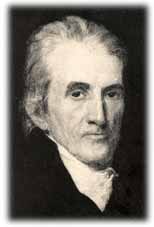Yale Abolitionists
Yale
Abolitionists
Samuel Hopkins
James Hillhouse
Simeon Jocelyn
The Amistad Affair
James Pennington
Charles Torrey
Cassius Clay
1856 Kansas Meeting
|
James Hillhouse
 James
Hillhouse commanded the Governor's Foot Guard in New Haven during the
American Revolution, became active in early American politics, and served
as Yale's treasurer for fifty years. Hillhouse created the Grove Street
cemetery, lined New Haven's streets with the elm trees for which it
would become famous, and helped bring about the Farmington-New Haven
canal. James
Hillhouse commanded the Governor's Foot Guard in New Haven during the
American Revolution, became active in early American politics, and served
as Yale's treasurer for fifty years. Hillhouse created the Grove Street
cemetery, lined New Haven's streets with the elm trees for which it
would become famous, and helped bring about the Farmington-New Haven
canal.
Hillhouse did
not shy away from using his political strength to oppose slavery and
to extend the democratic ideals of the early republic to all its members.
According to a statement by The Amistad Committee and Yale's Gilder
Lehrman Center: (54)
One of Hillhouse's most
important, but least-remembered roles, however, was that of the antislavery
leader of the U. S. Congress in the early days of the republic ...
As early as 1799, Senator Hillhouse served on a committee to investigate
the ending of the slave trade, which he helped to pass at the earliest
constitutionally-authorized moment. After the Louisiana Purchase of
1803, Hillhouse fought to bar the importation of slaves into the Louisiana
Territory. "I consider slavery as a serious evil," he proclaimed,
"and wish to check it wherever I have authority." Two of Hillhouse's
amendments restricting slavery actually passed the Congress and were
signed into law. Although the stiffest restrictions did not pass,
the historian Don Fehrenbacher asserts that "the magnitude of [Hillhouse's]
effort ought to be recognized." His amendments constituted, "the strongest
antislavery restriction imposed on any portion of the Deep South between
1735 and 1865." Proslavery forces soon overwhelmed Hillhouse's restrictions,
however, and the Louisiana Territory became the heartland of the cotton
explosion, embedding slavery inextricably into the fabric of the nation.
Just as his service as Yale's
treasurer spanned many years, so too did his anti-slavery activism:
During the Missouri controversy
of 1819-21, he circulated an attack on the institution that was so
blistering that his colleagues in Washington warned that it might
incite Southern representatives to disunion.
James Hillhouse understood
that the ideals of democracy were incompatible with the existence of
slavery. Unlike John C. Calhoun
or Samuel F. B. Morse, Hillhouse
proclaimed that the ideals of democracy were more important.
There is no Yale building
named after James Hillhouse. The City of New Haven remembers him with
"Hillhouse Avenue," the street connecting Yale's central and science
campuses, and with "Hillhouse High School." This high school used to
stand between Broadway and the Tower Parkway, but in the 1950s Yale
purchased this land from the city and razed the buildings to make space
for two more residential colleges-Stiles College and Morse College-and
the high school moved further out from town.
From September 13-15, 2001,
The Amistad Committee has scheduled, jointly with Yale's Gilder Lehrman
Center, a ceremony to honor Hillhouse's anti-slavery advocacy. September
is official Connecticut Freedom Trail Month. Since there is no "Hillhouse"
building on Yale's campus, the Saturday ceremony will be held at his
gravesite in the Grove Street Cemetery, and in the Hall of Graduate
Studies.
|
Numbers in parentheses refer
to notes. See the notes page.
|

 James
Hillhouse commanded the Governor's Foot Guard in New Haven during the
American Revolution, became active in early American politics, and served
as Yale's treasurer for fifty years. Hillhouse created the Grove Street
cemetery, lined New Haven's streets with the elm trees for which it
would become famous, and helped bring about the Farmington-New Haven
canal.
James
Hillhouse commanded the Governor's Foot Guard in New Haven during the
American Revolution, became active in early American politics, and served
as Yale's treasurer for fifty years. Hillhouse created the Grove Street
cemetery, lined New Haven's streets with the elm trees for which it
would become famous, and helped bring about the Farmington-New Haven
canal.